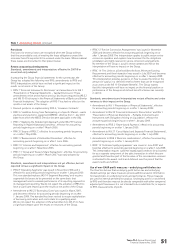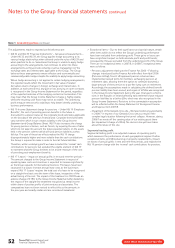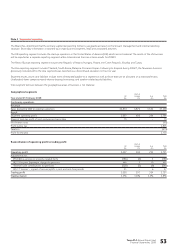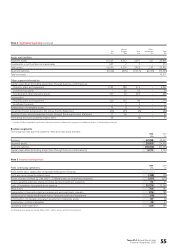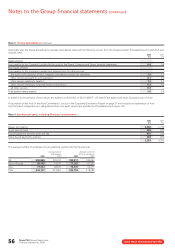Tesco 2008 Annual Report Download - page 53
Download and view the complete annual report
Please find page 53 of the 2008 Tesco annual report below. You can navigate through the pages in the report by either clicking on the pages listed below, or by using the keyword search tool below to find specific information within the annual report.
Tesco PLC Annual Report and
Financial Statements 2008 51
Provisions
Provisions for onerous leases are recognised when the Group believes
that the unavoidable costs of meeting the lease obligations exceed the
economic benefits expected to be received under the lease. Where material
these leases are discounted to their present value.
Recent accounting developments
Standards, amendments and interpretations effective for 2007/8 or
issued and early adopted:
In preparing the Group financial statements for the current year, the
Group has adopted the following new IFRS, amendments to IFRS and
IFRIC Interpretations which have not had a significant impact on the
results or net assets of the Group:
> IFRS 7 ‘Financial Instruments: Disclosures’ and amendments to IAS 1
‘Presentation of Financial Statements – Capital Disclosures’. These
amendments revise and enhance previous disclosures required by IAS 32
and IAS 30 ‘Disclosures in the Financial Statements of Banks and Similar
Financial Institutions’. The adoption of IFRS 7 has had no effect on the
results or net assets of the Group.
> Revised guidance on implementing IFRS 4, ‘Insurance Contracts’.
> IFRIC 6 ‘Liabilities Arising from Participating in a Specific Market – waste
electrical and electronic equipment (WEEE)’, effective from 1 July 2007
(date from which the WEEE Directive became applicable in the UK).
> IFRIC 7 ‘Applying the Restatement Approach under IAS 29 Financial
Reporting in Hyperinflationary Economics’, effective for accounting
periods beginning on or after 1 March 2006.
> IFRIC 8 ‘Scope of IFRS 2’, effective for accounting periods beginning
on or after 1 May 2006.
> IFRIC 9 ‘Reassessment of Embedded Derivatives’, effective for
accounting periods beginning on or after 1 June 2006.
> IFRIC 10 ‘Interims and Impairment’, effective for accounting periods
beginning on or after 1 November 2006.
> IFRIC 11 ‘Group and Treasury Share Transactions’, effective for accounting
periods beginning on or after 1 March 2007 was early adopted by
the Group.
Standards, amendments and interpretations not yet effective, but not
expected to have a significant impact on the Group:
> IFRS 8 ‘Operating Segments’ was issued in November 2006 and is
effective for accounting periods beginning on or after 1 January 2009.
This new standard replaces IAS 14 ‘Segment Reporting’ and requires
segmental disclosures to be presented on the same basis that
management uses to evaluate performance of its reporting segments in
its management reporting. We do not expect the adoption of IFRS 8 to
have a significant impact upon the results or net assets of the Group.
> Amendment to IAS 23 ‘Borrowing Costs’ was issued in March 2007,
and becomes effective for accounting periods beginning on or after
1 January 2009. The standard has been revised to require capitalisation
of borrowing costs when such costs relate to a qualifying asset.
We do not expect the adoption of the amendments to IAS 23 to have
a significant impact upon the results or net assets of the Group.
> IFRIC 12 ‘Service Concession Arrangements’ was issued in November
2006 and becomes effective for accounting periods beginning on or
after 1 January 2008. This interpretation applies to public sector service
concession operators and explains how to account for the obligations
undertaken and rights received in service concession arrangements.
No member of the Group is a public sector operator and hence this
interpretation will have no impact on the Group.
> IFRIC 14 ‘The Limit on a Defined Benefit Asset, Minimum Funding
Requirements and their Interaction’ was issued in July 2007 and becomes
effective for accounting periods beginning on or after 1 January 2008.
This interpretation provides guidance on how to assess the limit on the
amount of surplus in a defined benefit scheme that can be recognised
as an asset under IAS 19 ‘Employee Benefits’. The Group expects
that this interpretation will have no impact on the financial position or
performance of the Group as all defined benefit schemes are currently
in deficit.
Standards, amendments and interpretations not yet effective and under
review as to their impact on the Group:
> Amendment to IAS 1 ‘Presentation of Financial Statements’, effective
for accounting periods beginning on or after 1 January 2009.
> Amendment to IAS 32 ‘Financial Instruments: Presentation’ and IAS 1
‘Presentation of Financial Statements – Puttable Instruments and
Instruments with Obligations Arising on Liquidation’, effective for
accounting periods beginning on or after 1 January 2009.
> Amendment to IFRS 2 ‘Share-based Payment’, effective for accounting
periods beginning on or after 1 January 2009.
> Amendment to IAS 27 ‘Consolidated and Separate Financial Statements’,
effective for accounting periods beginning on or after 1 July 2009.
> Amendments to IFRS 3 ‘Business combinations’, effective for accounting
periods beginning on or after 1 January 2010.
> IFRIC 13 ‘Customer loyalty programmes’ was issued in June 2007 and
becomes effective for accounting periods beginning on or after 1 July 2008.
This interpretation requires customer loyalty award credits to be accounted
for as a separate component of the sales transaction in which they are
granted and therefore part of the fair value of the consideration received
is allocated to the award credits and deferred over the period that the
award credits are fulfilled.
Use of non-GAAP profit measures – underlying profit before tax
The Directors believe that underlying profit before tax and underlying
diluted earnings per share measures provide additional useful information
for shareholders on underlying trends and performance. These measures
are used for internal performance analysis. Underlying profit is not defined
by IFRS and therefore may not be directly comparable with other companies’
adjusted profit measures. It is not intended to be a substitute for, or superior
to IFRS measurements of profit.
Note 1 Accounting policies continued












